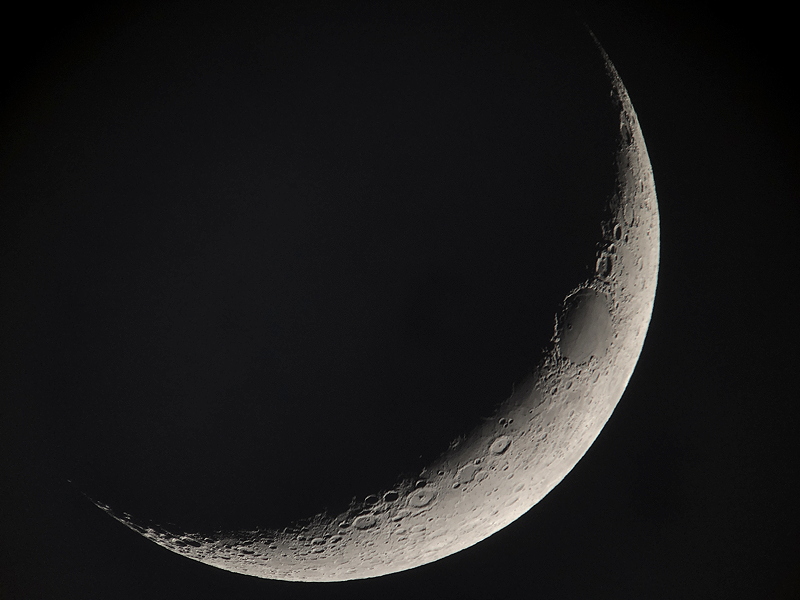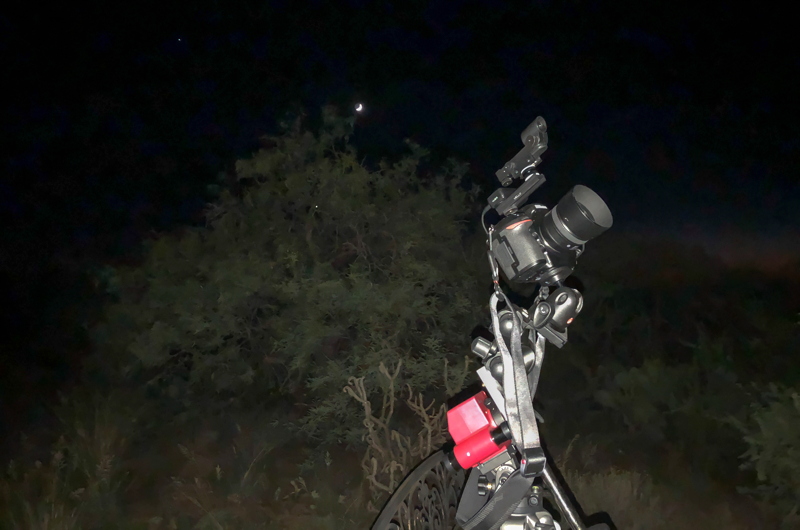D850 DSLR SkyTracker Pro:
Cassiopeia, Andromeda Galaxy, Helix Nebula
Posted: 13 September 2018
|
Open: Wednesday, 12 September 2018, 1828 MST Temperature: 82°F |
Session: 1277 Conditions: Clear |
Equipment Used:
12" f/8 LX600 w/StarLock
2" 24mm UWA eyepiece
SkyTracker Pro
Camera:
iPhone 8 Plus
D850 DSLR
1836 MST: sunset.
After the packrat visits over the last few sessions I set up a "live" trap near the observatory to try to capture the rascal.
1840 MST: LX600 ON, StarLock OFF, High Precision OFF.
Viewed Venus and then the Moon, 102X.
Took this handheld iPhone 8 Plus afocal 102X photo of the Moon:

1900 MST: viewed Jupiter, 102X. The four Galilean Moons and the Great Red Spot were visible. Then viewed Saturn, 102X. Four moons were visible against the still bright sky. Viewed Mars, 102X. The South Polar Cap, the North Polar Hood, and a dark surface area were visible.
1908 MST: did a polar alignment of the SkyTracker Pro that I had set up on the observatory patio.
Took these handheld D850 DSLR + 600mm lens photos (cropped) of the Moon:
Moon (f/6.3, 1/250sec, ISO 400):

Earthshine (f/6.3, 1/15sec, ISO 6400):

Took this handheld photo of the western sky, D850 DSLR + 50mm lens (f/1.4, 1/30sec, ISO 3200) showing Jupiter (left), Venus (bottom), the Moon with Earthshine:

1930 MST: mounted the D850 DSLR + 50mm lens on the SkyTracker Pro. This iPhone photo shows the setup with Jupiter, the Moon, and Venus (in the tree):

I attached the ScopeStuff Red Dot Finder and the Vello ShutterBoss wireless shutter release to the D850 using the Vello Extension Bar.
1945 MST: tweaked the STP polar alignment. I did a series of test images with the D850 DSLR + Nikon 50mm lens using the constellation of Cassiopeia as the target. Wide-open at f/1.4 there was some distortion in the corners. But at f/2.8 the image was very sharp, as seen in this f/2.8, 30 seconds, ISO 1600, White Balance 4000K, full-frame photo:

Cassiopeia is at the center with the Milky Way going vertically through the photo. The Double Cluster (open star clusters) is at the bottom.
I switched to the Tamron 150-600mm lens:

I did a series of test images at various ISO and White Balance settings of the Andromeda Galaxy (M31, M32, and M110), f/6.3, 30 seconds, FL 600mm. Here are two full-frame images:
Andromeda Galaxy (f/6.3, 30 seconds, ISO 25600, WB 4000K, FL 600mm):

Andromeda Galaxy (f/6.3, 30 seconds, ISO 6400, WB 4000K, FL 600mm):

Pretty impressive results.
Next, I viewed NGC7293 (Helix Nebula) using the Vortex 12x50 binoculars. It was faintly visible.
I then aimed the camera at NGC7293 (Helix Nebula) and did a series of test images. Here are three full-frame images, with the first showing how small (or large) the Helix Nebula is.
Helix Nebula (f/5, 30 seconds, ISO 6400, WB 4000K, FL 150mm):

Helix Nebula (f/6.3, 30 seconds, ISO 25600, WB 4000K, FL 600mm):

Helix Nebula (f/6.3, 30 seconds, ISO 6400, WB 4000K, FL 600mm):

2120 MST: ended imaging.
2133 MST: took a quick look at Mars, 102X.
2134 MST: LX600 OFF.
I checked the trap and it was empty. I did not hear the packrat this session.
|
Close: Wednesday, 12 September 2018, 2145 MST Temperature: 76°F |
Session Length: 3h 17m Conditions: Clear |
Comments are welcome using Email. Twitter users can use the button below to tweet this report to their followers. Thanks.
Cassiopeia Observatory Home Page
Copyright ©2018 Michael L. Weasner / mweasner@me.com
URL = http://www.weasner.com/co/Reports/2018/09/13/index.html
